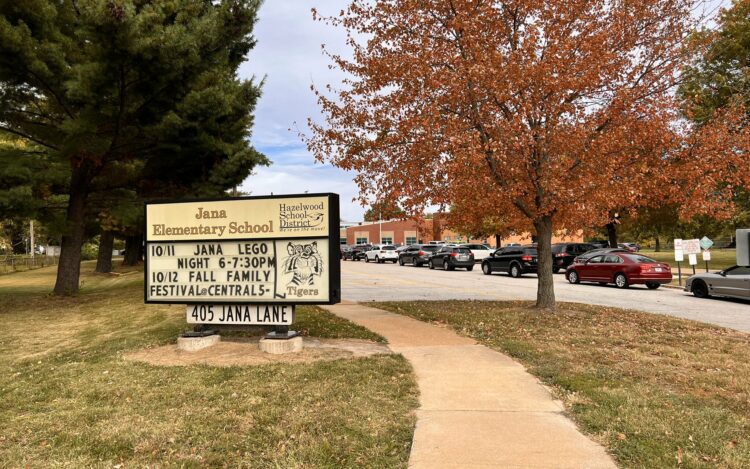A report stated that experts found excessive radioactive waste at Jana Elementary School in Florissant, Missouri.
Testing showed that Coldwater Creek in North St. Louis County, MO, was contaminated with radioactive waste due to nuclear bombs from World War II and low-lying areas near the creek were subject to flooding. Exposure to high levels of radioactive waste could be harmful.
Contaminated areas surrounded the elementary school on two sides: the creek and contaminated Moule Drive homes, prompting Boston Chemical Data to collect samples inside and outside the elementary school.
Boston Chemical Data revealed excessive levels of the radioactive isotope lead-210 were found on the school grounds. The level of Lead-210 found was more than 22 times the expected background, and more than two times the anticipated background for Radium-266 was found among other isotopes.
Hazelwood School District issued a statement.
“The Hazelwood School District is aware of the report regarding radioactive contamination at Jana Elementary,” the statement read. “Safety is always our top priority, and we are actively discussing the implications of the findings. The Board of Education will be consulting with attorneys and experts in this area of testing to determine next steps.”
— Hazelwood School District (@HazelwoodSD) October 14, 2022
The Army Corps detected radioactive thorium near the school in 2018, and further testing in 2019, 2020 and 2021 confirmed the results. However, they failed to collect samples from inside the school building and on the school grounds.
Concerned parents and environmental activists pleaded for the Army Corps and the school board to survey the school for toxic waste, inside and out, but many of them were denied.
“There is no safe level of bomb waste for children,” Karen Nickel, co-founder of the environmental activist group Just Moms STL, told the St. Louis Post-Dispatch.
The report concluded that “a significant remedial program will be required to bring conditions at the school in line with expectations for indoor spaces that are protective of all users regardless of age.”
Christen Commuso of the Missouri Coalition for the Environment implied that the toxic waste was the force that could drive parents away from enrolling their children.
“I wouldn’t want my child in this school,” she said. “The effect of these toxins is cumulative.”
After reading the report, Jana’s parent-teacher association president Ashley Bernaugh began to worry since her son attended Jana.
“I was heartbroken,” Bernaugh said. “It sounds so cliché, but it takes your breath from you.”
She added, “This has been in our community for over 80 years,” she said. “We expect the school board to make the agencies responsible for this to come in and clean it up.”
The toxic waste found near and in Coldwater Creek has been around for over 80 years, endangering many Missouri citizens’ lives. The Army Corps’ responsibility was to clean up the areas with high levels of toxic waste, which their remedial program, the Formerly Utilized Sites Remedial Action Program (FUSRAP), has been doing. Especially after a 2018 report came out linking Coldwater Creek’s contamination to the increased risk of some types of cancers in exposed residents.
Missouri Department of Health and Senior Services monitored cancer incidents and mortalities in the Coldwater Creek area from 1996 to 2011. The study found that cancer cases were significantly higher in ZIP codes 63031, 63033, 63042, 63134, and other combined areas. Jana Elementary’s ZIP code is 63031. And while children in 63031 weren’t significantly impacted by radioactive waste, the waste highly impacted the lives of children ages 17 and under in 63043, where seven cases of brain and other nervous system cancers were observed and higher than expected.
Studies show that children’s lives were at stake. So why the Army Corps and school board hesitated to test the inside and outside of Jana Elementary is unclear. The Agency for Toxic Substances and Disease Registry were so transparent that they released a report about the contamination and cancer link along with their recommendations on handling the matter and messages from concerned citizens. In one letter, a parent was worried after finding out that her neighborhood and the school would never be tested despite seeing kids play in the area, throwing stones from the creek, including her child.
“We didn’t know the creek by our house was Coldwater Creek,” the person wrote. “I also can see Jana Elementary from my backyard. I see kids out there year after year, in the field, within a stone’s throw of the creek. My 13-year-old son was one of those kids for 5 years. I know of 5 people in my neighborhood of 105 homes that have died from cancer in the last 5 years. According to the Coldwater Creek Facebook page, many more over the years, several from brain tumors, many lived on my street. Our area hasn’t been tested yet, and I was told it may never be tested. There is also easy access to the creek and tributary right behind our house.”
The message continued, “This is the ‘hangout’ for so many kids, who probably have no idea what they are playing in. There are NO SIGNS of any kind to warn of anything, and I have been told it’s because it doesn’t pose a significant threat. How does anyone really know this if it hasn’t been tested yet? Judging from the number of cancers in my neighborhood alone, I strongly disagree. I, like many of my neighbors, feel stuck and don’t want to pass this problem on to somebody else, like so many others have.”
Community members went further and expressed their concerns about how the students at the school were consuming foods and beverages like milk supplied by farms near Coldwater Creek.
The ATSDR even recommended that the FUSRAP program “continue investigating and cleaning up Coldwater Creek sediments and floodplain soils to meet regulatory goals” and stated that sampling and testing inside and outside places near the creek were needed to get a better assessment of who’s endangered and how much the waste has spread.
Combining ATSDR’s recommendations and pleas from concerned citizens, it’s a big wonder why these weren’t enough to convince the school board and the Army Corps to examine the school property to ensure the safety of the children.
And while this isn’t to directly state that race was the sole factor in the Army Corps and school board’s lack of concern for student safety, it’s important to point out that a little over 50% of Florissant, MO, is white while a little over 30% of the city is Black.
The Army Corps did test the city and the areas around the elementary school but not the school itself. The Boston Chemical Data Corp. stepped in and conducted its testing inside and outside Jana Elementary School. According to Great Schools, over 80% of Jana Elementary School’s students are Black, 14% are white, 2% are Hispanic, and 1% are of two or more races.
This isn’t to say race is a factor in everything. However, environmental racism exists. One study from Environmental Health Perspectives showed that non-Hispanic Blacks had higher levels of exposure to pollution than whites due to segregation. Factories that emit pollutants are placed in majority Black neighborhoods, harming children and adults, especially those with underlying conditions like asthma.
Cancer Alley, a well-known region in Louisiana, is a prime example of environmental racism. A rubber plant owned by Denka Performance Elastomer in St. John the Baptist Parish is why Cancer Alley has its name. According to ProPublica, the cancer risk in the area is up to 47 times what the EPA considered acceptable because it emits so many harmful chemicals impacting Black lives. About 1,500 feet from the factory is St. John the Baptist Parish’s Fifth Ward Elementary School, where high levels of Chloroprene were found in the school—the factory emits Chloroprene.
The EPA deemed Chloroprene carcinogenic to humans, and the National Air Toxics Assessment (NATA) reported that prolonged exposure to the chemical could cause liver and cardiovascular problems and damage the immune system. And instead of attempting to fix the issue, the Louisiana Department of Environmental Quality and the Louisiana Department of Health downplayed the chemical’s health risk and practically ignored citizens’ concerns.









